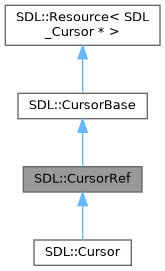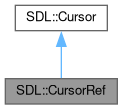Semi-safe reference for Cursor.


Public Member Functions | |
| CursorRef (CursorParam resource) noexcept | |
| Constructs from CursorParam. More... | |
| CursorRef (CursorRaw resource) noexcept | |
| Constructs from CursorParam. More... | |
| CursorRef (const CursorRef &other) noexcept | |
| Copy constructor. | |
| ~CursorRef () | |
| Destructor. | |
| constexpr | Cursor (std::nullptr_t=nullptr) noexcept |
| Default ctor. | |
| constexpr | Cursor (const CursorRaw resource) noexcept |
| Constructs from CursorParam. More... | |
| constexpr | Cursor (const Cursor &other)=delete |
| Copy constructor. | |
| constexpr | Cursor (Cursor &&other) noexcept |
| Move constructor. | |
| constexpr | Cursor (const CursorRef &other)=delete |
| constexpr | Cursor (CursorRef &&other)=delete |
| Cursor (const Uint8 *data, const Uint8 *mask, const PointRaw &size, const PointRaw &hot) | |
| Create a cursor using the specified bitmap data and mask (in MSB format). More... | |
| Cursor (SurfaceParam surface, const PointRaw &hot) | |
| Create a color cursor. More... | |
| Cursor (SystemCursor id) | |
| Create a system cursor. More... | |
 Public Member Functions inherited from SDL::Cursor Public Member Functions inherited from SDL::Cursor | |
| constexpr | Cursor (std::nullptr_t=nullptr) noexcept |
| Default ctor. | |
| constexpr | Cursor (const CursorRaw resource) noexcept |
| Constructs from CursorParam. More... | |
| constexpr | Cursor (const Cursor &other)=delete |
| Copy constructor. | |
| constexpr | Cursor (Cursor &&other) noexcept |
| Move constructor. | |
| constexpr | Cursor (const CursorRef &other)=delete |
| constexpr | Cursor (CursorRef &&other)=delete |
| Cursor (const Uint8 *data, const Uint8 *mask, const PointRaw &size, const PointRaw &hot) | |
| Create a cursor using the specified bitmap data and mask (in MSB format). More... | |
| Cursor (SurfaceParam surface, const PointRaw &hot) | |
| Create a color cursor. More... | |
| Cursor (SystemCursor id) | |
| Create a system cursor. More... | |
| ~Cursor () | |
| Destructor. | |
| constexpr Cursor & | operator= (Cursor &&other) noexcept |
| Assignment operator. | |
| constexpr CursorRaw | get () const noexcept |
| Retrieves underlying CursorRaw. | |
| constexpr CursorRaw | release () noexcept |
| Retrieves underlying CursorRaw and clear this. | |
| constexpr auto | operator<=> (const Cursor &other) const noexcept=default |
| Comparison. | |
| constexpr | operator bool () const noexcept |
| Converts to bool. | |
| constexpr | operator CursorParam () const noexcept |
| Converts to CursorParam. | |
| void | Destroy () |
| Free a previously-created cursor. More... | |
| void | Set () |
| Set the active cursor. More... | |
Additional Inherited Members | |
 Protected Member Functions inherited from SDL::Cursor Protected Member Functions inherited from SDL::Cursor | |
| constexpr Cursor & | operator= (const Cursor &other) noexcept=default |
| Assignment operator. | |
Constructor & Destructor Documentation
◆ CursorRef() [1/2]
|
inlinenoexcept |
- Parameters
-
resource a CursorRaw or Cursor.
This does not takes ownership!
◆ CursorRef() [2/2]
|
inlinenoexcept |
- Parameters
-
resource a CursorRaw or Cursor.
This does not takes ownership!
Member Function Documentation
◆ Cursor() [1/4]
|
inlineexplicitconstexprnoexcept |
- Parameters
-
resource a CursorRaw to be wrapped.
This assumes the ownership, call release() if you need to take back.
◆ Cursor() [2/4]
|
inline |
mask has to be in MSB (Most Significant Bit) format.
The cursor width (w) must be a multiple of 8 bits.
The cursor is created in black and white according to the following:
- data=0, mask=1: white
- data=1, mask=1: black
- data=0, mask=0: transparent
- data=1, mask=0: inverted color if possible, black if not.
Cursors created with this function must be freed with Cursor.Destroy().
If you want to have a color cursor, or create your cursor from an Surface, you should use Cursor.Cursor(). Alternately, you can hide the cursor and draw your own as part of your game's rendering, but it will be bound to the framerate.
Also, Cursor.Cursor() is available, which provides several readily-available system cursors to pick from.
- Parameters
-
data the color value for each pixel of the cursor. mask the mask value for each pixel of the cursor. size the width and height of the cursor. hot the x position of the cursor hot spot, from the top-left, in the range of 0 to size.x- 1 and 0 tosize.y- 1.
- Postcondition
- a new cursor with the specified parameters on success.
- Exceptions
-
Error on failure.
- Thread safety:
- This function should only be called on the main thread.
- Since
- This function is available since SDL 3.2.0.
◆ Cursor() [3/4]
|
inline |
If this function is passed a surface with alternate representations, the surface will be interpreted as the content to be used for 100% display scale, and the alternate representations will be used for high DPI situations. For example, if the original surface is 32x32, then on a 2x macOS display or 200% display scale on Windows, a 64x64 version of the image will be used, if available. If a matching version of the image isn't available, the closest larger size image will be downscaled to the appropriate size and be used instead, if available. Otherwise, the closest smaller image will be upscaled and be used instead.
- Parameters
-
surface an Surface structure representing the cursor image. hot the x, y position of the cursor hot spot.
- Postcondition
- the new cursor on success.
- Exceptions
-
Error on failure.
- Thread safety:
- This function should only be called on the main thread.
- Since
- This function is available since SDL 3.2.0.
◆ Cursor() [4/4]
|
inline |
- Parameters
-
id an SystemCursor enum value.
- Postcondition
- a cursor on success.
- Exceptions
-
Error on failure.
- Thread safety:
- This function should only be called on the main thread.
- Since
- This function is available since SDL 3.2.0.
- See also
- Cursor.Destroy
The documentation for this struct was generated from the following file:
- SDL3pp/SDL3pp_mouse.h